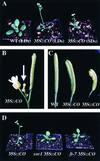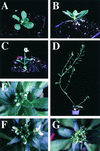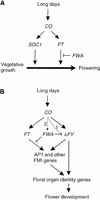Mutagenesis of plants overexpressing CONSTANS demonstrates novel interactions among Arabidopsis flowering-time genes
- PMID: 10852935
- PMCID: PMC149091
- DOI: 10.1105/tpc.12.6.885
Mutagenesis of plants overexpressing CONSTANS demonstrates novel interactions among Arabidopsis flowering-time genes
Abstract
CONSTANS (CO) promotes flowering of Arabidopsis in response to long photoperiods. Transgenic plants carrying CO fused with the cauliflower mosaic virus 35S promoter (35S::CO) flowered earlier than did the wild type and were almost completely insensitive to length of day. Genes required for CO to promote flowering were identified by screening for mutations that suppress the effect of 35S::CO. Four mutations were identified that partially suppressed the early-flowering phenotype caused by 35S::CO. One of these mutations, suppressor of overexpression of CO 1 (soc1), defines a new locus, demonstrating that the mutagenesis approach is effective in identifying novel flowering-time mutations. The other three suppressor mutations are allelic with previously described mutations that cause late flowering. Two of them are alleles of ft, indicating that FT is required for CO to promote early flowering and most likely acts after CO in the hierarchy of flowering-time genes. The fourth suppressor mutation is an allele of fwa, and fwa soc1 35S::CO plants flowered at approximately the same time as co mutants, suggesting that a combination of fwa and soc1 abolishes the promotion of flowering by CO. Besides delaying flowering, fwa acted synergistically with 35S::CO to repress floral development after bolting. The latter phenotype was not shown by any of the progenitors and was most probably caused by a reduction in the function of LEAFY. These genetic interactions suggest models for how CO, FWA, FT, and SOC1 interact during the transition to flowering.
Figures






Similar articles
-
CONSTANS activates SUPPRESSOR OF OVEREXPRESSION OF CONSTANS 1 through FLOWERING LOCUS T to promote flowering in Arabidopsis.Plant Physiol. 2005 Oct;139(2):770-8. doi: 10.1104/pp.105.066928. Epub 2005 Sep 23. Plant Physiol. 2005. PMID: 16183837 Free PMC article.
-
The SOC1-SPL module integrates photoperiod and gibberellic acid signals to control flowering time in Arabidopsis.Plant J. 2012 Feb;69(4):577-88. doi: 10.1111/j.1365-313X.2011.04813.x. Epub 2011 Nov 16. Plant J. 2012. PMID: 21988498
-
Two lily SEPALLATA-like genes cause different effects on floral formation and floral transition in Arabidopsis.Plant Physiol. 2003 Nov;133(3):1091-101. doi: 10.1104/pp.103.026997. Epub 2003 Oct 2. Plant Physiol. 2003. PMID: 14526112 Free PMC article.
-
The regulation of flowering time by daylength in Arabidopsis.Symp Soc Exp Biol. 1998;51:105-10. Symp Soc Exp Biol. 1998. PMID: 10645431 Review.
-
Plant development going MADS.Plant Mol Biol. 2001 Jul;46(5):515-20. doi: 10.1023/a:1010689126632. Plant Mol Biol. 2001. PMID: 11516144 Review.
Cited by
-
Phenotypes on demand via switchable target protein degradation in multicellular organisms.Nat Commun. 2016 Jul 22;7:12202. doi: 10.1038/ncomms12202. Nat Commun. 2016. PMID: 27447739 Free PMC article.
-
De Novo Characterization of Flower Bud Transcriptomes and the Development of EST-SSR Markers for the Endangered Tree Tapiscia sinensis.Int J Mol Sci. 2015 Jun 5;16(6):12855-70. doi: 10.3390/ijms160612855. Int J Mol Sci. 2015. PMID: 26057749 Free PMC article.
-
Molecular cloning and potential function prediction of homologous SOC1 genes in tree peony.Plant Cell Rep. 2015 Aug;34(8):1459-71. doi: 10.1007/s00299-015-1800-2. Epub 2015 May 14. Plant Cell Rep. 2015. PMID: 25972261
-
Identification of the CONSTANS-like family in Cymbidium sinense, and their functional characterization.BMC Genomics. 2023 Dec 18;24(1):786. doi: 10.1186/s12864-023-09884-3. BMC Genomics. 2023. PMID: 38110864 Free PMC article.
-
Whole-Genome Sequencing and RNA-Seq Reveal Differences in Genetic Mechanism for Flowering Response between Weedy Rice and Cultivated Rice.Int J Mol Sci. 2022 Jan 30;23(3):1608. doi: 10.3390/ijms23031608. Int J Mol Sci. 2022. PMID: 35163531 Free PMC article.
References
-
- Bell, C.J., and Ecker, J.R. (1994). Assignment of 30 microsatellite loci to the linkage map of Arabidopsis. Genomics 19, 137–144. - PubMed
-
- Bradley, D., Ratcliffe, O., Vincent, C., Carpenter, R., and Coen, E. (1997). Inflorescence commitment and architecture in Arabidopsis. Science 275, 80–83. - PubMed
Publication types
MeSH terms
Substances
LinkOut - more resources
Full Text Sources
Other Literature Sources
Molecular Biology Databases

